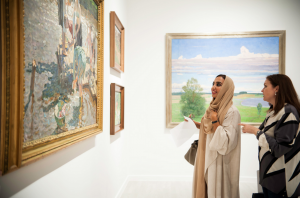Art is the answer but what is the question?
Mar 9th, 2017 | By Ivan Lindsay | Category: JournalWhile all the talking heads are poring over the just-released TEFAF 2017 Art Market Report (yawn…) one wonders who really looks and thinks about art any more. For those interested in number crunching the report it can be found here http://1uyxqn3lzdsa2ytyzj1asxmmmpt.wpengine.netdna-cdn.com/wp-content/uploads/2017/03/TEFAF-Art-Market-Report-20173.pdf
Today’s endless art courses teach branding and tie-ups between contemporary artists and luxury goods while artworks are pieces that are not sold but placed. Connoisseurship is mistrusted and scientific analysis is considered a more reliable judge of attribution. Bernard Berenson, that lover of tactile values and eye-based attributions, must be turning in his grave.
The art world has become a lifestyle, a dizzying rollercoaster of back-to-back art fairs and auctions. Record prices are plastered all over the news by the auction rooms PR departments. Endless bad press follows supposed revelations in the Panama papers and it has become popular for leading economists to ponce around in Davos accusing the art world of being a money-laundering machine. Most of these economists, Nouriel Roubini, Kenneth Rogoth etc, know little about money laundering and even less about the art world. If they ever tried either activity they would find that for money laundering what works best are businesses with multiple small cash transactions, the polar opposite of the art world. Art transactions are subject to the law of whatever country the deal is done and scrutinized in detail by bank’s compliance units.
In the middle of all this hype and negativity it is a relief to just focus on the art itself. When looking at a work of art it is important to cut out all surrounding noise and contemplate in silence. Most distracting is the silver-tongued patter of the salesman or the drone of the curator in the headphones. We try to ignore the opinions of others, but it is human to be influenced, particularly if we lack confidence in our ability to judge.
Kenneth Clarke, the 20th century art historian most famous for his TV series ‘Civilisation’ said that some people know what they are looking at, some people know what they are looking at when you tell them, and some people will never know what they are looking at even after you have told them. The safest response to an artwork is to trust your instinct, not dissimilar as how best to judge people. Some are born with this instinct, most can train it through knowledge and experience but some struggle and are untrainable.
Art is difficult to write about because, at its best, it communicates on a metaphysical level. Often we are aware something is very good but we are not sure why. It is much easier to describe why an artwork is not good. An artist tries to translate what he or she feels or sees. The great artists have unique vision and portray their images in a new way. Some artists try to get close to a truth where others distort reality to make us think. Picasso said, “Art is the lie that enables us to realize the truth.”
Great art supplies answers to questions that we hadn’t asked. In front of a fresh image that resonates we stop and examine our thoughts and emotions. We look at a strange cloud formation in a Rubens and think it looks impossible and then one day we see that exact sky and recall the painting. We see an expression of grief and pain in a Caravaggio and think it looks theatrical and yet, years later, we find ourselves looking at that same face reflected in a mirror. We look at Hirst and Koons and think they look ridiculous and ten years later…. they still look ridiculous.

A lady considers the Tkachev brothers 1956 painting ‘Laundresses’ at an exhibition in Abu Dhabi.
When it becomes crazy go to a great Museum, MOMA in New York, The Wallace Collection in London, the Frick, Kunsthistorische or the Prado, and spend a few hours in front of masterpieces. Man’s ultimate artistic creations are wholesome, challenging and uplifting and remind one that great art is timeless and will outlast all the current noise and distraction.
